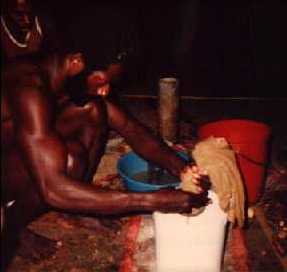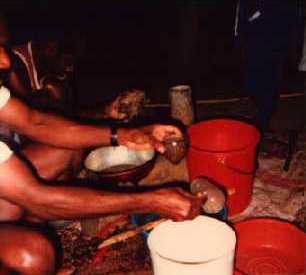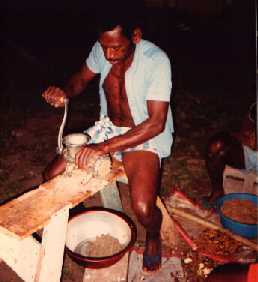
Pouring kava into a straining cloth. Photo ©S. Combs, 1987.

Squeezing kava out of the straining cloth. Photo ©S. Combs, 1987.
The ground kava is then mixed with water before the liquid is squeezed out one shell (half a coconut shell, the official volume measure of kava) at a time by hand and strained through a cone of fibrous "cloth" from a coconut palm trunk. Sometimes, it is strained all at once through a piece of woven polypropylene rice bag fabric. It is important not to strain the kava too thoroughly, because the fine kava particles must be left suspended in the liquid, as they contain the active ingredient.

Pouring a shell of kava. Photo ©S. Combs, 1987.
By this time, it is well dark and all the kava drinkers have drifted in. None have eaten yet, so as to get the greatest effect from the kava. The actual act of drinking each shell is solitary, performed at the nakamal's outer wall facing outwards. It is drunk with reverence, and then the men sit quietly, "listening to the kava". In many traditional village nakamals, speech is forbidden. By a couple of hours past nightfall, the men will have left the nakamal to have their evening meal, finish their day, and sleep.
Vanuatu kava is reputed to be the world's strongest, and is used almost exclusively as an intoxicant. This is not the weaker Fiji kava, which I am told is served during coffee breaks in offices. I was once at a government conference that was broken up by a kava ceremony; nobody was at all inclined to do any work for the remainder of the morning.
Kava's appearance is a bit like thin pea soup. To me, it tastes like dirty water with a hint of clove. Its first effect (after a successful effort to keep it down) is a slight numbing of the back of the throat, which probably accounts for the hawking and spitting that often follows drinking a shell. It is not like alcohol, in that one doesn't feel the systemic effects immediately, but after about ten minutes, it can suddenly hit your mind with a bang. This is especially true for experienced drinkers, as you learn with experience what to look for in the kava. First-timers can be lulled into a false sense of impunity by the lack of immediate apparent effect, have a couple of more shells, and fall on their faces when they stand up.
I have heard and read many times that kava does not cause a hangover, but it always gives me one as soon as its intoxicating effects wear off. I have heard of occasional deaths caused by mixing excessive amounts of kava and alcohol.
Unlike alcohol, kava does not cause aggressiveness. Ni-Vanuatu women prefer their men to drink kava because they come home, want sex, and then fall asleep; while a night of alcohol drinking can end with a wife-beating. While some Christian denominations have attempted to stamp out kava drinking since the arrival of their first missionaries, others quietly encourage its use as a less-harmful substitute for alcohol.
As a development adviser, I was favourably impressed by kava because commercial nakamals are the only sector of Vanuatu's money economy that is completely controlled by ni-Vanuatu. The urban nakamals are run along family lines, with the kava roots being grown by relatives back on the islands. They are sent to town on the coastal traders that buy copra (dried coconut meat, Vanuatu's main export, which is sent to Europe to be crushed for coconut oil). In town, nakamal businesses fail and re-open according to management ability and social distractions, but there are always many open at any one time. The commercial kava trade is a good way to get money out to the outer islands, and money spent on kava circulates among ni-Vanuatu. It is much less expensive than domestic or imported beer, and it is culturally and socially appropriate.
I always hoped that fresh food root crops could be imported into Vanuatu's towns by the same mechanisms as kava, but the villages who own the land where the towns are situated maintain a tight monopoly on the fresh food trade. Locally-raised food is very expensive in town, and most urban ni-Vanuatu are forced to subsist on white rice imported from Australia.
A Typical Evening At A Commercial Nakamal
A commercial nakamal is usually a rough shed made of woven bamboo, galvanized iron, lumber scraps, and whatever is available, with an earth floor. A simple counter at one end serves as a bar, and benches ring the outer wall; perhaps some more benches are outside. Lighting is provided by a single kerosene wick lamp or maybe a low-wattage bulb hanging from a wire near the bar. A similar arrangement hung out by the road advertises the nakamal's presence.

Preparing kava with a meat grinder, as is normally done in commercial nakamals. Photo ©S. Combs, 1987.
Late in the afternoon, the nakamal owner starts preparing the fresh kava by washing the roots and scraping off the skin. Commercial kava is usually ground with a large hand-cranked meat grinder into a plastic basin. It is then mixed with water and the kava drink is squeezed out through a woven plastic rice bag or a coarse cloth. Only the large particles are strained out; kava's active ingredient is not water-soluble and is found in the suspended particles in the liquid.
About sundown, the customers, both ni-Vanuatu and expatriate, start to arrive. They have not eaten, as kava is always drunk on an empty stomach so that one gets maximum effect. Women are allowed to buy and drink kava if they are not from the village of the nakamal owner, although I have heard bitter complaints that whitemen spoil (in a cultural sense) ni-Vanuatu women by taking them to kava bars.
Whatever lighting is available is turned on, and business commences. Each customer goes up to the bar and gives 50 vatu (1992 price, about CAN$0.45) to the owner. After the kava is stirred with a stick to keep the particles mixed with the water, the customer is given a half-coconut shell of kava (or, disappointingly often these days, a glass). The customer then quietly goes out of the nakamal to the edge of the nakamal yard, faces outward, and downs the kava in one draw. It tastes like dirty dishwater with a hint of cloves, maybe because of the slight anesthetic affect on the back of the throat. The dregs are usually poured on the ground, and a bout of hawking and spitting often follows. The customer goes back to the bar, where he returns the shell to the owner. The shell is then rinsed in a bucket of water, refilled, and balanced in an old tuna tin on the bar to await the next customer.
The customer then quietly returns to a bench, where he sits with his companions. He may stop at the bar on the way to purchase some locally-grown and roasted peanuts or bits of meat on a spit, or hard candies to eat and take away the kava taste. Depending on the nakamal's location and his preference, he may sit inside the nakamal's twilight, or he may go to a bench outside and watch the stars appear over Port Vila harbour. He and his companions quietly converse, almost at a whisper, and discuss the day's events. Some just sit in quiet contemplation.
Usually, a person waits a half-hour or so, and perhaps has another shell. That is usually it. By 20:00, about two hours after they have opened, most nakamals are empty and shut down. The customers have drifted off for supper somewhere.
There are certainly many, many ni-Vanuatu men who drink kava in their village every night. Many expatriates, especially single men with no reason to get home early in the evening, also drink kava every night. Some of them become somewhat emaciated because they habitually forget to eat properly after visiting the nakamal with an empty stomach. When it comes time to leave Vanuatu, however, all the nakamal regulars just up and go, giving up kava with no withdrawal symptoms. It is generally agreed along the nakamal bench that kava can be psychologically addictive, but not physically.
Kava is not an illegal substance in North America; I have declared it at both United States and Canada Customs. I understand that relatively small amounts are imported by ethnic Pacific communities. Dried kava powder can be purchased in Port Vila and Luganville and mailed overseas. Some westerners have urged the Government of Vanuatu to get into large-scale production of freeze-dried kava and export it to Europe and North America for sale in health and grocery stores. My guess is that North America probably wouldn't welcome large volumes of yet another intoxicating drug, and the first kava-induced automobile fatality would lead to tight regulation.
Kava In Another Society Where It Is Not A Tradition
I have heard that missionaries have introduced kava to some Australian Aboriginal settlements as a substitute for socially-destructive alcohol. Without Vanuatu's traditional social constraints against over-indulgence, though, it just became another abused drug.
John Fowler learned to love Kava while living in Vanuatu in the '60s so much that he is growing it in Hawaii. His Nuka Hiva Trading site tells great tales of his experience with Kava in the then-New Hebrides, as well as offering kava shoots for sale to those who would like to grow their own.
Brian L. Dear's "The Taste Of Money: The Kava Market Takes Off" gives the complete low-down on the growing kava market in the United States.
Lee Kagan's Kava Page shows how he researched kava on the internet and lists many kava references.
Hawaii's kava tradition is presented on the Kava - Drug of Choice In the Pacific site, from where Hawaiian kava can be mail-ordered.
Kule'a Farm Kava Co.'s site, also from Hawaii, spices its information about kava's production and use with early literary references. Besides kava, this company sells traditional coconut cups and Fijian tanoa (kava bowls), by mail-order.
©Stan Combs, 1995 - 1998